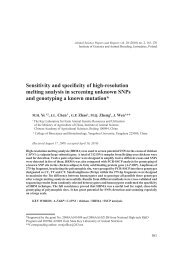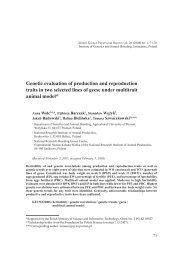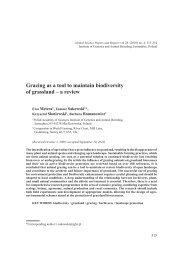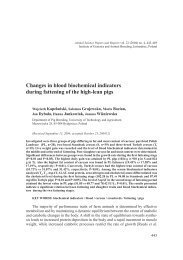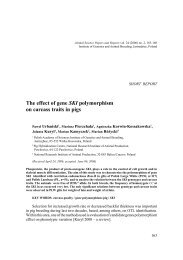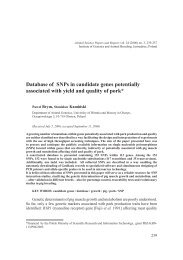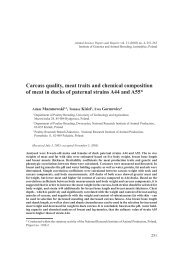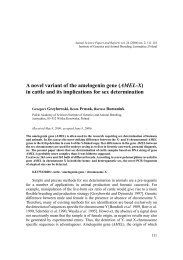Hoof size as related to body size in the horse (Equus caballus)
Hoof size as related to body size in the horse (Equus caballus)
Hoof size as related to body size in the horse (Equus caballus)
Create successful ePaper yourself
Turn your PDF publications into a flip-book with our unique Google optimized e-Paper software.
A. Stachurska et al.<br />
Table 3. Correlation coefficients (r) between <strong>body</strong> and hoof parameters (3)<br />
Trait<br />
Toe length<br />
<strong>Hoof</strong> solar<br />
length<br />
<strong>Hoof</strong> width<br />
Total hoof<br />
solar length<br />
and width<br />
All ratios relat<strong>in</strong>g <strong>the</strong> hoof dimensions <strong>to</strong> <strong>the</strong> wi<strong>the</strong>rs height, chest circumference<br />
and cannon circumference varied with regard <strong>to</strong> <strong>the</strong> breed (Tab. 4). The ratios grew<br />
accord<strong>in</strong>g <strong>to</strong> <strong>the</strong> grow<strong>in</strong>g <strong>in</strong>dex of bon<strong>in</strong>ess <strong>in</strong> particular breeds. In PA <strong>the</strong> ratios were<br />
lower than <strong>in</strong> AA and <strong>in</strong> <strong>the</strong> latter turned out <strong>to</strong> be lower than <strong>in</strong> PK mares. The ratios<br />
<strong>in</strong> question were <strong>the</strong> highest <strong>in</strong> PCB mares. These trends were regular apart from<br />
<strong>the</strong> <strong>to</strong>e length and hoof solar length <strong>to</strong> chest circumference ratios similar <strong>in</strong> PK and<br />
PCB mares, <strong>as</strong> well <strong>as</strong> <strong>the</strong> <strong>to</strong>tal hoof solar length and width <strong>to</strong> cannon circumference<br />
smaller <strong>in</strong> heavy-boned PCB than <strong>in</strong> PK mares. Most differences <strong>in</strong> <strong>the</strong> ratios between<br />
breeds were significant except for <strong>the</strong> <strong>to</strong>e length <strong>to</strong> chest circumference and <strong>the</strong> <strong>to</strong>tal<br />
hoof solar length and width <strong>to</strong> cannon circumference. Regard<strong>in</strong>g <strong>the</strong> former ratio, PA<br />
differed from o<strong>the</strong>r breeds, while with respect <strong>to</strong> <strong>the</strong> latter ratio, significantly different<br />
were PK mares.<br />
The hoof <strong>to</strong> <strong>body</strong> dimension ratios were similar <strong>in</strong> consecutive age groups (Tab.<br />
5). There were significant differences solely between 4-6 and 7-9-year old mares <strong>in</strong><br />
<strong>the</strong> hoof solar length <strong>to</strong> <strong>the</strong> height at wi<strong>the</strong>rs ratio, <strong>as</strong> well <strong>as</strong> <strong>in</strong> <strong>the</strong> <strong>to</strong>tal hoof solar<br />
length and width compared <strong>to</strong> <strong>the</strong> height at wi<strong>the</strong>rs.<br />
The hoof <strong>to</strong> <strong>body</strong> dimensions ratios <strong>in</strong>cre<strong>as</strong><strong>in</strong>g <strong>in</strong> breeds along with <strong>the</strong> <strong>in</strong>dex of<br />
bon<strong>in</strong>ess show <strong>the</strong> hoof <strong>size</strong> is <strong>related</strong> <strong>to</strong> this trait. The <strong>in</strong>dex of bon<strong>in</strong>ess describes <strong>the</strong><br />
type of <strong>the</strong> <strong>horse</strong> by relat<strong>in</strong>g <strong>the</strong> cannon thickness <strong>to</strong> <strong>the</strong> height at wi<strong>the</strong>rs. The cannon<br />
me<strong>as</strong>ured should not show pathological alterations. It reflects <strong>to</strong>tal ossa metacarpus<br />
and tendons circumference. S<strong>in</strong>ce <strong>the</strong> bone perimeter is <strong>the</strong> ma<strong>in</strong> fac<strong>to</strong>r def<strong>in</strong><strong>in</strong>g <strong>the</strong><br />
thickness of <strong>the</strong> cannon, it may be found that <strong>the</strong> hoof <strong>size</strong> <strong>related</strong> <strong>to</strong> <strong>the</strong> <strong>in</strong>dex of<br />
bon<strong>in</strong>ess results ma<strong>in</strong>ly from <strong>the</strong> bone dimension. Thus, <strong>the</strong>re is no uniform ratio<br />
for <strong>Equus</strong> <strong>caballus</strong> but <strong>the</strong> hoof <strong>size</strong> should be considered with respect <strong>to</strong> <strong>the</strong> type of<br />
<strong>the</strong> <strong>horse</strong>. This is <strong>in</strong> accordance with Butler [1995] who reported that <strong>the</strong> hoof <strong>size</strong><br />
cor<strong>related</strong> with <strong>the</strong> bone dimension. In <strong>the</strong> present study <strong>the</strong> <strong>to</strong>tal hoof solar length<br />
and width <strong>to</strong> cannon circumference ratio w<strong>as</strong> one of <strong>the</strong> le<strong>as</strong>t differentiated hoof <strong>to</strong><br />
<strong>body</strong> traits ratios with regard <strong>to</strong> <strong>the</strong> <strong>horse</strong> breed. This proportion closely <strong>related</strong> <strong>to</strong> <strong>the</strong><br />
bone thickness and simultaneously be<strong>in</strong>g less variable than o<strong>the</strong>r ratios, additionally<br />
documents <strong>the</strong> Butler’s [1995] f<strong>in</strong>d<strong>in</strong>g. The ratio <strong>in</strong> question w<strong>as</strong> higher only <strong>in</strong> PK<br />
mares. It may be suggested that th<strong>in</strong>ner bones and greater hooves result from <strong>the</strong><br />
specific orig<strong>in</strong> of this primitive breed descendent from <strong>the</strong> Tarpan (<strong>Equus</strong> <strong>caballus</strong><br />
gmel<strong>in</strong>i) – Pruski [1959].<br />
218<br />
Height at wi<strong>the</strong>rs 0.474 0.410 0.505 0.469<br />
Chest circumference 0.797 0.814 0.882 0.865<br />
Cannon circumference 0.837 0.926 0.953 0.956<br />
All coefficients significant at P≤0.01.



